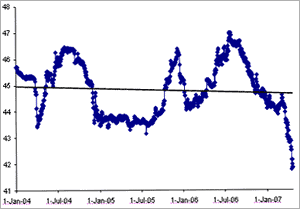|
|
| Help | |
| You are here: Rediff Home » India » Business » Personal Finance » Manage your Money |
|
| |||||||||||||||||||||||
|
| |||||||||||||||||||||||
Investing in India is like homecoming for many Non-Resident-Indians. Having earned their incomes in foreign lands, they invest in India, an economy whose workings they understand; in companies, whose names and products they are familiar with, and in the land where they spent their childhood.
What determines the return for an NRI?
When you are thinking of investing, you are concerned about getting your money back. Unlike the consumption flows -- the money that the NRIs sent to their relatives in India for their existence -- investing demanded that you consider the returns that you would get and benchmark them against the opportunities in your country of residence.
For the foreign investor, return in local currency = return on Indian asset + change in exchange rate. Hence, when investing in India, there were two variables that an NRI had to consider: the returns on assets in India and the exchange rate risk.
The logic of investing
Those, as they say, were simpler times. The logic of investing in India used to work like this:
Up to 2003: The interest rate in India is higher and hence even if you put in money into fixed deposits there at 8-9% and the rupee depreciates by 2-3% every year (which it had steadily done since the 1991 liberalisation), you stood to make 5-7% returns in your local currency.
Since the bull run of 2003: Once the world decided that India was an integral component of the future growth (BRIC, superpower by 2050, demographic dividend, etc) and the Indian corporates started put on a spectacular show of profits, there was no stopping the equity markets -- and after that the real estate market. Annual returns over the last 3-4 years have been in excess of 30% year-on-year. A 2-3% depreciation in the rupee did not matter in such heady markets.

So what has changed now?
Investing in India typically meant worrying about the first part of the return equation. There was hardly any detailed analysis done -- or required -- on the second part of the equation: the currency changes. It was generally assumed that Indian rupee will keep depreciating.
That logic has been completely reversed -- especially over the last few months. From a low of Rs 44.6128 to a US dollar on March 6 to a high of Rs 41.18 on April 24, the 6.6% appreciation in 1� months has meant that NRIs now need to work with the possibility of sudden changes in the Indian rupee also.
The gain in the value of the rupee has been beneficial to the foreign investor. If you invest in the assets of a currency that appreciates (as the rupee has done) then you benefit. This however poses one question for the NRIs: has the rupee appreciated so much that it will fall, reducing their returns?
With the sluggishness in the real estate market and volatile returns in the equity markets, is this the time to start reviewing their investments here?
The way forward:
When any investment is not a one-way street, making an investment strategy for it is of critical importance. In a one-way market (either rising or falling), you can take a position more clearly (invest or divest completely). However, when the market movement is not very clear -- at least in the short term -- the way forward needs to be gradual increase in exposure.
Instead of going in for a one time exposure, a gradual build-up in the position is advisable.
What do I do with my current investments? With gains in stock market, real estate and in rupee, the investor is expectedly sitting on some profits. Just as it is advisable to have a defined asset allocation, currency allocation should be a defined driver of reorganizing the portfolio.
Asset allocation (into equity, debt, real estate, etc) is primarily determined by considerations to milestones, liquidity, tax, income and capital appreciation requirements. Open currency exposures, especially at the retail level might not be necessary.
The exposure should be arrived at if there are any milestones in the particular currency. For example, if you are investing in India so that you can spend you retirement here, then you need to have exposure to Indian rupee.
However, if you are investing in India to grow your wealth, you need to do a status check on your returns till date and you might want to consider converting some profits to cash.
How do I invest in the future? As India starts getting more integrated into the global economy, investing in India will now increasingly involve forecasting the direction and magnitude of interest rate change. This forecasting is similar to the analysis done on asset class returns.
From a retail investor's point of view, the way to beat the volatility in the rupee is to do what has been oft recommended for equities: do a systematic investment plan (SIP). The chart above clearly suggests that the 'average value' of the rupee has fluctuated widely over the last three years: if you had invested on the 1st of every month since Jan 2004, you would have received an average rate of Rs 44.8413.
NRI investment typically happens in a chunky manner: when the NRI is in the country and approaches / is approached by his banker / advisor to invest his yearly savings into funds or real estate. The idea should be to move towards a more spread-out investing through out the year.
This will not only help beat the volatility in the asset returns but will help you better the currency fluctuations also.
The author is Director, PARK Financial Advisors Pvt Ltd, Mumbai. He is an IIM-Ahmedabad alumnus. He can be contacted at info@parkfa.com
|
|
| © 2007 Rediff.com India Limited. All Rights Reserved. Disclaimer | Feedback |